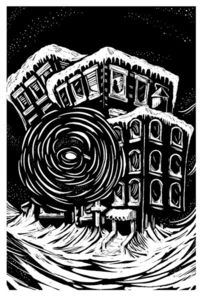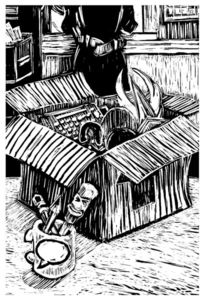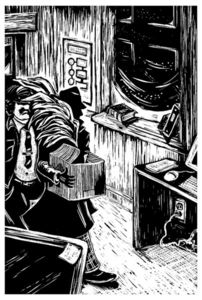Mark Huebner Takes Us Into the World of Let Go, His Wordless Novel About Memory & the Weight of the Past
Writer and artist Mark Huebner set himself a unique challenge in his new book Let Go (Porcupine's Quill): storytelling without using a single word.
Let Go is an entirely wordless novel, told in Huebner's hauntingly beautiful block prints. Its title refers to the protagonist's long, cold walk home after losing his job, and how he is forced to decide whether to (literally) hold onto his past or not.
Evocative and moving, Let Go asks us, without a single word or question mark, where the value of memory truly lies. A meditation on how the past can weigh us down and lift us up all at once, it is thoughtful storytelling done in a wildly creative format.
The book is available for pre-order now from Porcupine's Quill, coming out in January 2021.
We're excited to welcome Mark to Open Book to tell us more about Let Go and how he tackled the unique challenges of wordless writing. He tells us how Let Go grew organically from a 15 print short story to its impressive final count of 135 unique images, describes the process of writing over two dozen endings before finding the right conclusion to his story, and shares what is so powerful about some favourite graphic novels from two titans of the form.
Open Book:
Tell us about your new book and how it came to be.
Mark Huebner:
Let Go is a wordless novel about an adman who loses his long-time job. A fierce blizzard forces to walk home, carrying his cardboard box packed with mementos.
The storm forces him to either hang on or let go of his reminders of a happier time.
It originally began as a wordless short story told in 15 lino block prints. As the project expanded, I wrote in more characters and expanded the story.
OB:
Did this project change significantly from when you first started working on it to the final version? How long did the project take from start to finish?
Your CanLit News
Subscribe to Open Book’s newsletter to get local book events, literary content, writing tips, and more in your inbox
MH:
From conception to publication, the scope of Let Go changed significantly.
The project began when I was invited by Porcupine’s Quill Graphic Novels Editor George Walker to contribute to an anthology of wordless fiction. Five other graphic novelists were also involved. My contribution was limited to 15 or 20 lino blocks. I wrote a short narrative and started the process of learning how to carve the lino block illustrations.
Over the weeks and months, each of the other contributors dropped out of the project for different reasons. Every time one did, George asked me if I could increase the page count. I could and I did.
By the time it was up to 45 pages, George said that if I could do 60 that I could have my own title. Let Go as published will be 135 illustrations.
OB:
What do you need in order to write – in terms of space, food, rituals, writing instruments?
MH:
My preferred place to write is in an office with a door. Working in advertising forced me to adapt to write productively in a lot of challenging work environments. I can write in a bar or restaurant, but only in a booth. I can write on a streetcar, but not a bus or subway. I can draw outside but I rarely write outside. I enjoy writing longhand with a fountain pen as it allows me to sketch.
OB:
What do you do if you’re feeling discouraged during the writing process? Do you have a method of coping with the difficult points in your projects?
MH:
Working as a copywriter has taught me that the solution to any writing problem is writing more. The biggest challenge of writing Let Go was deciding on the ending. I wrote at least two dozen of them.
I was able to start carving the lino blocks without an ending because it would only change two or three blocks at the end. Eventually I wrote a good ending and kept carving.
I was nearly finished when I had the inspiration for the right ending. I feel that I wouldn’t have found the right ending if I hadn’t gone ahead with a good ending.
OB:
What defines a great book, in your opinion? Tell us about one or two books you consider to be truly great books.
MH:
A great book is one that stays with me long after I’ve finished reading it. It is also one that comes to mind when I’m reading subsequent books.
In the realm of graphic novels, Art Spiegelman’s Maus and Will Eisner’s A Contract With God are great books. In Maus, Spiegelman’s art serves the story. In A Contract With God, Eisner articulates narratives through movement, gesture, and richly expressive characters. Even the city becomes a character.
OB:
What are you working on now?
MH:
I’m drawing and carving the lino blocks for Off the Cuff. It’s a wordless comedy of a contemporary young man who is experiencing the worst thing ever just before an important job interview. Unlike Let Go, it was conceived as a full-length wordless novel and has just one ending. It will be published by The Porcupine’s Quill in spring 2022.
__________________________________________________________
Mark Huebner is a Canadian advertising copywriter and commercial illustrator. After studying film directing and screenwriting at New York University, Oral Roberts University, and University of Winnipeg, Mark started his career in film production before discovering that copywriting provided a broader channel for his compelling narratives. He is the author of Sports Bloopers: All-Star Flubs and Fumbles (Firefly Books, 2003), a YALSA Quick Pick for Reluctant Young Adult Readers. Let Go is his first published work of fiction. He lives in Toronto.






